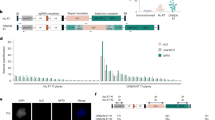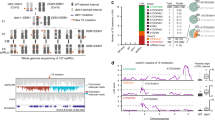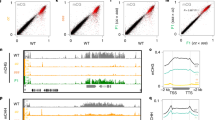Abstract
A significant proportion of the genomes of higher plants and vertebrates consists of transposable elements and their derivatives. Autonomous DNA type transposons encode a transposase that enables them to mobilize to a new chromosomal position in the host genome by a cut-and-paste mechanism. As this is potentially mutagenic, the host limits transposition through epigenetic gene silencing and heterochromatin formation. Here we show that a transposase from Arabidopsis thaliana that we named DAYSLEEPER is essential for normal plant growth; it shares several characteristics with the hAT (hobo, Activator, Tam3) family of transposases1. DAYSLEEPER was isolated as a factor binding to a motif (Kubox1) present in the upstream region of the Arabidopsis DNA repair gene Ku70 (refs 2, 3). This motif is also present in the upstream regions of many other plant genes. Plants lacking DAYSLEEPER or strongly overexpressing this gene do not develop in a normal manner. Furthermore, DAYSLEEPER overexpression results in the altered expression of many genes. Our data indicate that transposase-like genes can be essential for plant development and can also regulate global gene expression. Thus, transposases can become domesticated by the host to fulfil important cellular functions.
This is a preview of subscription content, access via your institution
Access options
Subscribe to this journal
Receive 51 print issues and online access
$199.00 per year
only $3.90 per issue
Buy this article
- Purchase on Springer Link
- Instant access to full article PDF
Prices may be subject to local taxes which are calculated during checkout


Similar content being viewed by others
References
Rubin, E., Lithwick, G. & Levy, A. A. Structure and evolution of the hAT transposon superfamily. Genetics 158, 949–957 (2001)
Bundock, P., van Attikum, H. & Hooykaas, P. J. J. Increased telomere length and hypersensitivity to DNA damaging agents in an Arabidopsis KU70 mutant. Nucleic Acids Res. 30, 3395–3400 (2002)
Rhia, K., Watson, J. M., Parkey, J. & Shippen, D. E. Telomere length and enhanced sensitivity to genotoxic stress in Arabidopsis mutants deficient in Ku70. EMBO J. 21, 2819–2826 (2002)
Kempken, F. & Windhofer, F. The hAT family: a versatile transposon group common to plants, fungi, animals and man. Chromosoma 110, 1–9 (2001)
Kunze, R. et al. Dominant transposition-deficient mutants of maize Activator (Ac) transposase. Proc. Natl Acad. Sci. USA 90, 7094–7098 (1990)
The Arabidopsis Genome Initiative, Analysis of the genome sequence of the flowering plant Arabidopsis thaliana. Nature 408, 796–815 (2000)
Mack, A. M. & Crawford, N. M. The Arabidopsis TAG1 transposase has an N-terminal zinc finger DNA binding domain that recognizes distinct subterminal motifs. Plant Cell 13, 2319–2331 (2001)
Aravind, L. The BED finger, a novel DNA-binding domain in chromatin-boundary-element-binding proteins and transposases. Trends Biochem. Sci. 25, 421–423 (2000)
Lundquist, E. A. et al. The mec-8 gene of C. elegans encodes a protein with two RNA recognition motifs and regulates alternative splicing of unc-52 transcripts. Development 122, 1601–1610 (1996)
Kidwell, M. G. & Lisch, D. R. Transposable elements and host genome evolution. Trends Ecol. Evol. 15, 95–99 (2000)
Lippman, Z. et al. Role of transposable elements in heterochromatin and epigenetic control. Nature 430, 471–476 (2004)
Pardue, M. L. & DeBaryshe, P. G. Retrotransposons provide an evolutionarily robust non-telomerase mechanism to maintain telomeres. Annu. Rev. Genet. 37, 485–511 (2003)
Han, J. S., Szak, S. T. & Boeke, J. D. Transcriptional disruption by the L1 retrotransposon and implications for mammalian transcriptomes. Nature 429, 268–274 (2004)
Hudson, M. E., Lisch, D. R. & Quail, P. H. The FHY3 and FAR1 genes encode transposase-related proteins involved in regulation of gene expression by the phytochrome A-signalling pathway. Plant J. 34, 453–471 (2003)
Wang, H. & Deng, X. W. Arabidopsis FHY3 defines a key phytochrome A signalling component directly interacting with its homologous partner FAR1. EMBO J. 21, 1339–1349 (2002)
Meijer, A. H., Ouwerkerk, P. B. F. & Hoge, J. H. C. Vectors for transcription factor cloning and target site identification by means of genetic selection in yeast. Yeast 15, 1407–1415 (1998)
Acknowledgements
We thank V. Lanquar, Z. Li, A. den Dulk-Ras and M. Corredor for technical assistance, and S. de Pater, P. Ouwerkerk and B. van der Zaal for comments on the manuscript. P.B. and P.H. are supported by the EU FP5 project PLANTREC, the Technology Foundation STW, the Applied Science Division of NWO, and the Technology Programme of the Ministry of Economic Affairs.
Author information
Authors and Affiliations
Corresponding author
Ethics declarations
Competing interests
The sequence of the cDNA clone of At3g42170 has been submitted to GenBank (AY728267). Reprints and permissions information is available at npg.nature.com/reprintsandpermissions. The authors declare no competing financial interests.
Supplementary information
Supplementary Figure S1
Alignment of Daysleeper with the transposases from the mobile elements Activator (Ac) from maize, Tam3 from Antirhinum majus and Tag1 from Arabidopsis thaliana. Phylogenetic tree showing Daysleeper homologues from other plant species. (DOC 44 kb)
Supplementary Figure S2
Gel shift and one-hybrid analysis to map the Daysleeper binding site in the AtKU70 promoter. Binding of Daysleeper to another promoter containing the Kubox1 motif. (JPG 124 kb)
Supplementary Figure S2 Legend
Legend to Supplementary Figure S2. (DOC 21 kb)
Supplementary Figure S3
Sequence of the AtKU70 promoter showing the imperfect direct Kubox1 repeats. (DOC 20 kb)
Supplementary Figure S4
Gel shift assay showing the requirement of the Daysleeper BED-type zinc finger for DNA binding. (JPG 17 kb)
Supplementary Figure S4 Legend
Legend to Supplementary Information D1 (DOC 22 kb)
Supplementary Figure S5
Mapping the T-DNA insertion point in DAYSLEEPER. (DOC 21 kb)
Supplementary Table S1
Table of Arabidopsis genes containing part of the Kubox1 motif in their promoter region. (DOC 62 kb)
Supplementary Table S2
Table of Arabidopsis genes showing altered expression after DAYSLEEPER overexpression. (DOC 121 kb)
Rights and permissions
About this article
Cite this article
Bundock, P., Hooykaas, P. An Arabidopsis hAT-like transposase is essential for plant development. Nature 436, 282–284 (2005). https://doi.org/10.1038/nature03667
Received:
Accepted:
Issue Date:
DOI: https://doi.org/10.1038/nature03667
This article is cited by
-
Identification and characterization of RuvBL DNA helicase genes for tolerance against abiotic stresses in bread wheat (Triticum aestivum L.) and related species
Functional & Integrative Genomics (2023)
-
Genome-wide association analysis of 101 accessions dissects the genetic basis of shell thickness for genetic improvement in Persian walnut (Juglans regia L.)
BMC Plant Biology (2022)
-
The genome of Aechmea fasciata provides insights into the evolution of tank epiphytic habits and ethylene-induced flowering
Communications Biology (2022)
-
A genome-wide comparative evolutionary analysis of zinc finger-BED transcription factor genes in land plants
Scientific Reports (2022)
-
Genome-Wide Association Study Dissects Resistance Loci against Bacterial Blight in a Diverse Rice Panel from the 3000 Rice Genomes Project
Rice (2021)
Comments
By submitting a comment you agree to abide by our Terms and Community Guidelines. If you find something abusive or that does not comply with our terms or guidelines please flag it as inappropriate.



